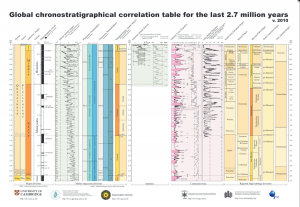The Quaternary Period is the geologic timeframe representing the last 2.58 Million years of Earth’s history. It is composed of 2 epochs including the Pleistocene (2.58 Million yrs to 11.7 thousand years) and the Holocene (from 11.7 thousand years to today). Most of us would agree that the Holocene ended and the Anthropocene epoch started (arguably)at the beginning of the Industrial Revolution in the late 18th century because of human induced climate change, but that subdivision is not yet official. As a recent NASA outreach effort stated – Earth: its changing and you are on it!
At the University of Massachusetts-Amherst, Quaternary studies are conducted all over the world — from both terrestrial and marine geologic archives and even subsurface archives in natural cave systems. The Hartshorn Quaternary Lab (named in memory of Professor Joe Hartshorn) is one of the hubs of the Department where initial core descriptions are carried out and samples are initially processed for additional analytical work.

The Hartshorn Quaternary Lab has all of standard laboratory equipment and core description space necessary for the analysis of sediments and organics. Besides a Core Wall Station, the room is equipped with a state-of-the-art Geotek core splitter, and Geotek Multi-sensor core logger (for high resolution photography, color scanning, magnetic susceptibility and gamma density). The new laboratory equipment inventory also includes a Cox Analytical Systems Itrax XRF core scanner to produce optical RBG and micro-x-radiographic images, and magnetic susceptibility, as well as heavy and light elemental profiles in high resolution from centimeter to submillimeter scales. This instrument can be used to scan marine and lake cores for paleoclimate and other research interests. The Itrax scanner is housed in the XRF laboratory. Muffle ovens are available for LOI, a Coulter LS 200 laser particle analyzer is available for particle-size analysis. An X-Ray Diffractometer is available for clay analyses. A cold room (+4 oC) with a capacity for 1000m of core storage is new since 2008.
The laboratory managed by Julie Brigham-Grette and Ray Bradley is also equipped with the necessary field and laboratory equipment for work on lakes and in fjords in remote regions including a UWitec Coring system, and SeaBird Seacat CTD mounted with an optical backscatter turbidity sensor (OBS) and dissolved oxygen sensor, small boats and a few good motors.
